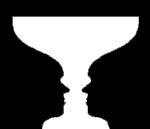| What do
you see here? Do you see the profiles of two heads or a vase?
Notice how the image
fluctuates between the two possibilities even though the image on your
retina remains constant. It is difficult to perceive both meaningful images
simultaneously.
So What's Going On?
The Rubin vase/profile
illusion is an ambiguous figure/ground illusion. This is because it can
be perceived either as two black faces looking at each other, in front
of a white background, or as a white vase on a black background.
In the case of a figure/ground
reversal one line can have two shapes. The shape of the contour formed
depends on which side of the line is regarded as part of the figure. This
is important, because the visual system represents or encodes objects primarily
in terms of their contours. Also, elements that are close to one
another or alike or homogeneous in certain respects tend to be grouped
together. This is called grouping. The sudden reversal that you perceive
may be due to your shift of attention on the shape of the contour. The
observer's "perceptual set" and individual interests can also bias the
situation. Biasing the shapes or contours can make one interpretation stronger
than the other one. As one can see in the three-dimensional model of the
vase, which biases the vase.
There is no doubt that
this particular illusion occurs involves higher cortical processing. This
is because you have stored information in your brain that contains knowledge
about vases and profiles.
Your brain needs to be
able to interpret the patterns in your eye in terms of external objects.
To do this your visual system needs to be able to distinguish objects (figure)
from their background (ground). Most of the time this is relatively easy,
but sometimes, as in the case of camouflage, it can be made much more difficult.
The vase/profile illusion
is important because it shows that perception is not solely determined
by an image formed on the retina. The spontaneous reversal that you observe
illustrates the dynamic nature of subtle perceptual processes. These processes
underscore how your brain organizes its visual environment.
Origins of the Rubin
Face/Vase Illusion
The vase/profile illusion
was made famous by Danish psychologist Edgar Rubin in 1915. Its pedigree,
however, is much older. Examples can be found in 18th century French prints,
in which the portraits not only define a vase, usually in a naturalistic
setting, but the profiles themselves differ, each representing a particular
person.
Stanford psychologist Roger Shepard made the drawing
seen above. In this case, you can see the profiles of two women, or you
can see an obscured face in back of the candlestick. Here, normality depends
on seeing one face rather than two.
Dutch graphic artist M.
C. Escher's ability to design ambiguous figure/ground prints
made him famous. More examples of his work can be seen in the Illusion
Art gallery contained on the CD.
|

